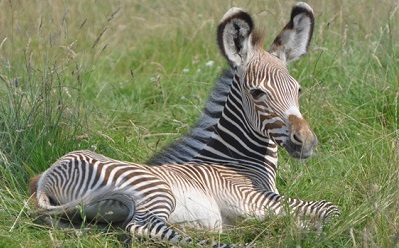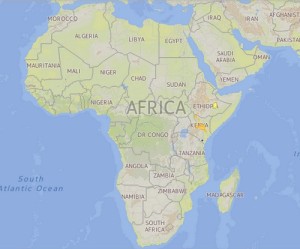Name
- Scientific name: Equus grevyi. The word equus is from the Latin word for “horse”. This species was named Grevyi after Jules Grèvy, president of the Third Republic of France in the late 18th century who was given one of these zebras as a gift in 1882.
- Common name: Grevy’s zebra, Imperial zebra. The word zebra comes from the Old Portuguese word zevro for “wild ass”.
Taxonomy

A baby Grevy’s zebra from the Zoological Society of London Whipsnade Zoo. Grevy’s zebra is considered an Endangered species by the IUCN.
- Kingdon: Animalia
- Phylum: Chordata
- Class: Mammalia
- Order: Perissodactyla
- Family: Equidae
- Genus: Equus
- Species: Equus grevyi
o
o
Species of zebra
- Plains zebra ( Equus quagga) – IUCN Status Least Concern
- Mountain zebra (Equus zebra)- IUCN status Vulnerable
- Grevyi’s zebra (Equus Grevyi) – IUCN Status Endangered
Habitat
- Grevy’s zebras inhabit hot and dry semi desert areas including arid grasslands and acacia savannas near sources of water.
- During the dry season they are more concentrated near permanent sources of water. During the rainy season they scatter to other territories.
- Young males and lactating females seek more green grass than other zebras.
Distribution
- Grevy’s zebra was historically distributed across the Horn of Africa but today it is limited to the arid areas of southern Ethiopia and northern Kenya.
- This species has suffered the largest reduction in range of any African mammal.
- There are small isolated populations and its range is very fragmented.
- It is extinct in Somalia and Sudan.
Population
- The population of Grevy’s zebra is estimated to have declined more than 50% over the past 18 years.
- According to the IUCN its current population stands at 750 mature individuals with the largest subpopulation at 255 mature animals.
- Its population trend is stable.
Physical Features
- The Grevy’s zebra is the largest of all the wild horses.
- Their stripes are the narrowest, closer together and larger in number than those of other zebra species.
- The pattern of stripes in a zebra is unique just like fingerprints.
- They have large rounded ears and a brown muzzle.
- They have 44 teeth.
- Males are only 10% larger than females and have large upper canine teeth, females lack canines.
- They have a black stripe along the spine with black and white alternating stripes spiraling down the body towards the legs and hooves. The belly is solid white.
- The stripes provide camouflage against predators.
- Its tail measures 22 in or 55 cm.
- Foals are born with red brown stripes and gradually darken as they become adults.
Weight and Height
- Males weigh up to 994 lb or 451 kg, while females up to 772 lb or 350 kg.
- Grevy’s zebras can reach lengths from 8.2 to 9.8 ft or 2.5 to 3 m.
Behavior
- Zebras sleep an average of 7 hours a day.
- They spend 50% of their time grazing.
- Grevy’s zebras do not migrate if there is no shortage of water and food.
- Non territorial Grevy’s zebras occupy the largest home range of any hoofed animal, about 3,861 sq mi or 10,000 sq km.
- Breeding males are territorial and occupy from 0.8 to 4.6 sq mi or 2 to 12 sq km. They mark their territories with urine and piles of dung called middens. These zebras have the right to access females in estrous within their territory.
- Grevy’s zebras do not have a social structure, contrary to Plains and Mountain zebras that live in herds. The only social unit is mothers with their young. Group composition can vary every day.
- Grevy’s zebras are more vocal than mountain zebras but not as vocal as plains zebras.
- They can gallop at up to 34 mph or 55 km/hr.
- When in the same territory they temporarily group together for protection.
Diet
- Zebras are herbivores. Their main food is grass but during the dry season they also browse on leaves.
- Grevy’s zebras can go without water for 5 days. Lactating females need to drink at least every other day to maintain milk production.
Reproduction
- Females reach reproductive maturity at around 3 years old and males at around the age of 6.
- They can reproduce at any time of year but breeding is concentrated from July to October.
- Gestation is about 390 days. Foals are born during the rainy months.
- If conditions are met females give birth every two years to 1 offspring.
- Pregnant females isolate themselves from other zebras days before giving birth and after the foal is born so that it can bond with its mother. The newborn foal can recognize its mother scent, appearance and sounds.
- The mother nurses its young for about 9 months.
- There is no paternal care for the young.
Life Expectancy
- Grevy’s zebras live from 22 to 30 years in captivity.
- In the wild they live for up to 12 or 13 years. The oldest animal reported in the wild lived to 18 years old.
Predators
- Lions, cheetahs, hyenas, African wild dogs, leopards.
Threats
- Habitat loss and degradation.
- Competition for resources with other grazers and reduction of water sources.
- In some regions zebras are hunted for their meet, skin and for medicinal use.
- High mortality of foals.
Conservation Status
- The IUCN lists the Grevy’s zebra as an Endangered species.
- It is listed in Appendix I of CITES.
Fun Facts about Zebras
- The Equidae (horse) family departed from rhinos 58 million years ago.
- The three main divisions in the horse family are caballines (domestic horse), asses and zebras.
- Grevy’s zebra has about 80 stripes, Plains zebra 25 to 30 stripes and Mountain zebra about 43.
- Zebras can be seen as black animals with white stripes, as white animals with black stripes or as animals with black and white stripes.
- Researches can identify zebras 90% of the times due to their unique stripe pattern.
References and further research
IUCN Red List of Threatened Species – Equus Grevyi
African Wildlife Foundation – Grevy’s Zebra
Smithsonian National Zoological Park – Grevy’s Zebra
Grevy’s Zebra Trust – About Grevy’s Zebra
San Diego Zoo Library – Equus Grevyi
University of Michigan Museum of Zoology – Equus Grevyi (Grevy’s zebra)
Conservation and Management Strategy for Grevy’s Zebra (Equus Grevyi) in Kenya
